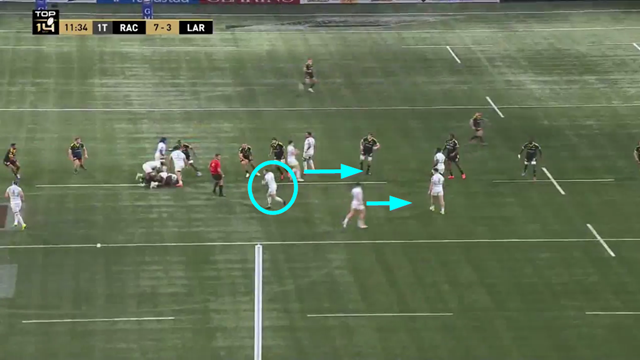As a coach, once you have begun to create options around one play in attack, you can start to think about building a wider repertoire, based on the same formations and distribution of personnel. If your charges can learn to run one play exceptionally well, you will force opponents to adjust to it – and that will create opportunities elsewhere.
As we saw in the previous article based upon Ireland’s kick return try against France from the 2023 Six Nation, setting up first phase in midfield will often present a nice balance of options to either side of the field. The defence needs to mark both sides of the pitch, and the uncertainty about the direction of the next phase of attack tends to have an inhibiting effect on line-speed on defence.
Many good attacking sides like to show they are prepared to attack on the near or ‘switchback’ side of the pitch if the defence tries to stay aggressive, build numbers and reinforce the rush by wrapping three forwards around the open-side corner of the first ruck.
‘21’ is the accepted terminology for this option: there are two phases [“2”] and the attack returns to the original, or first site of the set-piece [“1”]. Option-building from the ‘21’ is therefore an important offensive weapon, especially if you know that the opposition will have access to game-film of your previous exploits and be able to prepare for them.
Let’s take a look at a couple of examples from recent footage of Parisian club Racing 92, now coached by ex-England and Leinster coach Stuart Lancaster. Lancaster is an expert at building the detail into precisely the kind of attacking repertoire we are trying to build.
In the round six Top 14 game against Toulon, Racing’s young English sensation Henry Arundell scored a superb try from the 21 formation with a lineout starter:

After a set-up phase in midfield, all the three Racing inside backs [#10 Antoine Gibert, #12 Henri Chavancy and #13 Gael Fickou] shift to the open-side to encourage defensive movement in that direction. The key receiver on the second play, full-back Max Spring [circled] stays as long as possible behind the ruck, leaving it late to begin his run back to the near-side to avoid tipping off the direction of attack.
As important as the delay in Spring’s attacking motion is the detail in the support run of the intended strike-runner, Arundell:

The young Englishman doesn’t simply languish on the right touch-line and wait for play to come back to him. He first advances towards the ruck in midfield to reinforce the impression that the attack is going the other way, and only then curls out to the right. In American Football that would be called a ‘square-out’ receiving route. The square-out positions Arundell neatly in the gap between the last Toulon forward and the first back, and he scores easily.
A couple of weeks later, Racing had the opportunity to build their 21-based repertoire against European Champions La Rochelle. In this case the 21 was a decoy:

The scrum-half [Nolann Le Garrec] and full-back [Arundell, in a shift of roles] both move towards the near-side, as if the play which worked so well against Toulon will be repeated. But in this instance, the play reverses back to Gibert on the open-side, with a clear chance to hit left wing Juan Imhoff on the cross-kick:
Summary
Both the La Rochelle right wing and full-back are caught defending well inside the right 15m line, and if the kick goes to hand it will be a relatively simple finish for the Argentine international.
‘If you build it, they will come’, to rephrase a famous quotation from the movie Field of Dreams. If you can build a top-quality attacking play that demands respect from the defence, it will attract a repertoire of variations which you can use to exploit it successfully. The devil is in the detail: every player must know their own role, and understand why he/she has to implement it accurately. It is not enough to wait for the ball to come to you, you have to go looking for it, proactively.












.jpg)

.jpg)







